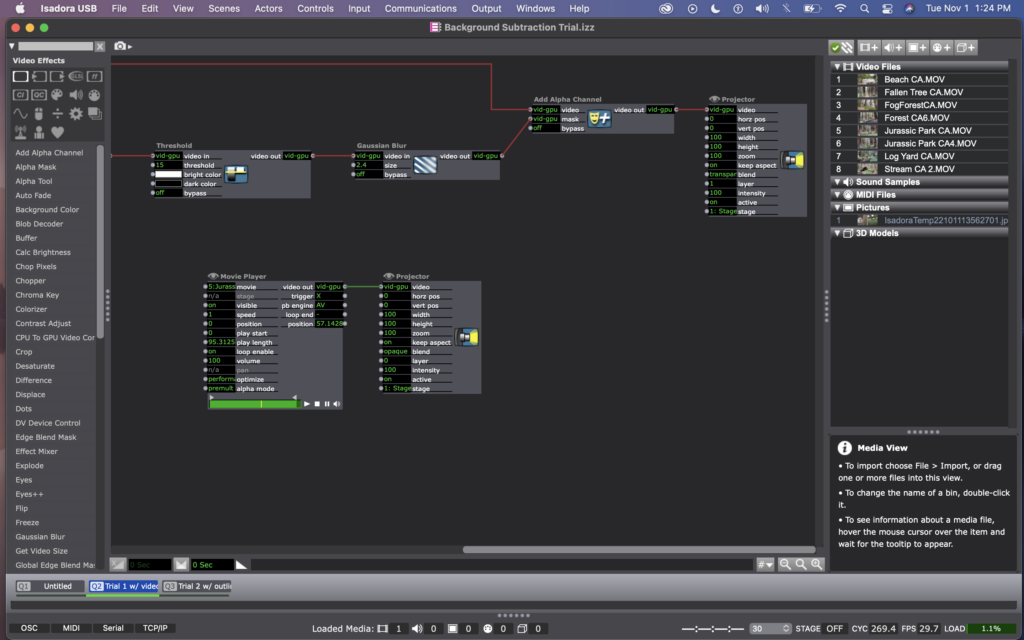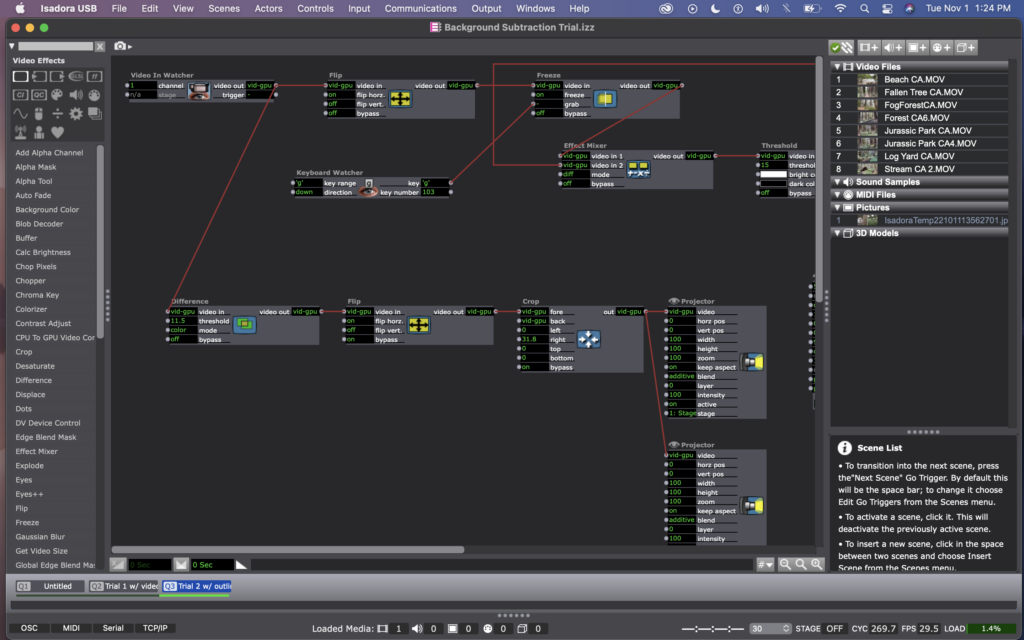Cycle 1 – Ghosts in the Landscape – Mollie Wolf
Posted: November 2, 2022 Filed under: Uncategorized Leave a comment »For cycle 1, I decided to attempt an interactive portion of my installation. My initial idea was to use an Astra or Kinect, with a depth sensor to make the background invisible and layer live capture footage of audience members into a video of a landscape.
When I asked Alex for help in background subtraction, he suggested I use a webcam instead. We found an example patch that Mark had posted on Toikatronix for background subtraction, so I started there.
He essentially used an effects mixer with a threshold actor to read the data from a video in watcher, and identify when a person had entered the frame – by watching for a change in light, compared to a freeze frame grab of the same image. Then, he used an add alpha channel actor to mask anything that hadn’t changed (i.e. the background).
Here are photos of my version of Mark’s background subtraction patch.


When I was first using this patch, it was a little finicky – sometimes only showing portions of the body, or flickering images of the background, or showing splotchy images. I noticed that it had a hard time with light colors (if the person was wearing white, as well as if their skin was reflecting the light in the room). I tried to fix this by adjusting the threshold number and by adding a gaussian blur to the image, but it still was more finicky than I’d like.
When I brought this issue up to Alex, he suggested that I could use a difference actor instead to do something similar. However, with the difference actor, it is mostly recognizing the outline of bodies rather than picking up the whole image of a person. I decided that I actually liked this better, aesthetically anyway – it made for ghost-like images to be projected in to the landscape, rather than video images of the people.
Here are photos of my current patch, using a difference actor. (The top line with the flip, freeze, effect mixer, etc – is still there from the previous attempt, but the projector is not active, so you can ignore that).


I think this method worked way better because it was no longer dependent on light in the room, and instead just on motion. (Which is way better for me, considering that I’m practicing this all in the Motion Lab with black walls and floors, but will be presenting it in Urban Arts Space with white walls and concrete floors). Conceptually, I like this version more as well, as it is an abstraction of people’s bodies and action, rather than a direct representation of it.
As a last minute experimentation, I laid out some platforms in the space and roughly lined them up with where there were mounds/hills in the landscape – that way if someone stood on the platform, it would look like their corresponding ghost image had climbed up the hill.
When I presented this version to the class, I was pleased to see how playful everyone became. With it just being an outline of their bodies, they were not looking at an image of themselves, and so there didn’t seem to be any amount of self-consciousness that I would expect if everyone were looking in a mirror, for example. People seemed to have genuine delight in figuring out that they could move through the landscape.
One interesting thing about the difference actor, is that non-moving bodies blend into the background (with no motion, there is no difference, frame be frame). So when someone decides to sit or stand rather than moving around, their ghost image disappears. While this is an inevitable aspect of the difference actor, I kind of like the metaphor behind this – you have to actively, physically engage in order to take effect on your environment.
We spent some time with the camera in a few different locations (to the side or in front of people). As we were discussing together, we came to a consensus that it was more magical/interesting when the camera was to the side. It was a, less obvious in terms of how to move (i.e. not as easy as looking into a mirror), which added to the magic. And having the camera to the side also meant that the landscape image was not obscured from view by anything. People only knew where the camera was if they went searching for it.
Here is a video of my peers interacting with the patch/system.